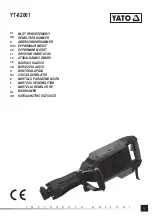
OVERHAUL
The disassembly and re-assembly procedure can be accomplished by utilizing the following instructions
and drawings. Use extreme care during disassembly and re-assembly not to mar or nick any smooth
surface that comes in contact with seals. Before installing seals, always apply a good lubricant, such as
Lubriplate, to the surfaces. It is recommended that tool kit (GBP740TK) be used to facilitate overhaul. It
includes items (44-50). A complete overhaul can be achieved by the use of Service Kit 744016 which
contains a complete set of o'rings, back-up rings, screws, washers and gasket.
WARNING
DEPRESS TRIGGER AND DISCONNECT FROM AIR WITH HEAD PISTON IN THE REAR POSITION BEFORE
OVERHAUL. SEVERE PERSONAL INJURY MAY OCCUR IF AIR HOSE IS NOT DISCONNECTED.
USE
CAUTION
WHEN FORCING PISTON ROD ASSEMBLY DOWNWARD WITH HEAD ASSEMBLY REMOVED,
HYDRAULIC FLUID WILL EJECT FORCIBLY FROM HANDLE.
HEAD
Remove nose assembly from tool before attempting disassembly of head assembly.
Remove end cap (10). Push against threaded end of head piston (6) to slide it out of head cylinder (1). Be
careful not to damage threads or cause burrs on polished piston rod surface.
The re-assembly sequence is the opposite of disassembly. (See Filling and Bleeding instructions.)
Apply loctite #242 and torque the four button-head cap screws (16) uniformly to 40 inch lbs. to prevent
leakage around the gasket.
HANDLE
To inspect air cylinder bore, remove parts (41) and (42). Any further disassembly will require removal of
the head assembly first. For complete disassembly, start by removing parts (41) and (42). Next, holding tool
upright, remove four button-head cap screws (16). Lift head assembly from handle (17) and set aside o'ring
(12) and gasket (13). Empty all hydraulic fluid into a container. Place piston rod wrench (44) down into top
of power cylinder, into the hex of piston rod assy. (22). While holding this wrench, remove flexlock nut (40)
using a 7/16" socket wrench. Still holding piston rod wrench, remove air piston (39) using packing plug
wrench (45), by turning counterclockwise. When air piston is completely free from piston rod, tap or push
on the piston rodw wrench to eject air piston from bottom of handle. After removal of air piston, slide piston
rod (22) back up to the end of its travel. Using packing plug wrench (45) remove packing plug (36). With
packing plug removed, power cylinder (18) can be removed by pushing on power cylinder tool (46) when
inserted into top of power cylinder.
To reassemble the handle, reverse the above procedure, being certain that all o'rings are properly lubricated
before installation. Torque packing plug (36) to 45 foot lbs. Attach the seal guide (47) to the piston rod (22)
and tap the piston rod through the packing plug (36). Attach air piston (39) and flexlock nut (40) torque
flexlock nut (40) to 40 inch lbs. Attach air piston (39) to piston rod (22). With the piston rod in the down
position, fill oil passage on top of handle with automatic transmission fluid, ATF220 or equivalent, when
looking at top of handle the oil passage is the hole that has a counterbore for S832 o'ring. Replace gasket
(13) and o'ring (12), just prior to replacing head assembly. (See Filling & Bleeding instructions.)
AIR VALVE
To disassemble, first disconnect tool from its air source. Remove pin (32) and muffler (31). Insert valve
extractor (48) into end of valve plug (30) and pull it out. Using the same procedure, pull out spool (28).
NOTE: It should never be necessary to remove valve sleeve (25) unless the ports in the sleeve are plugged
from contaminated air. If ports are plugged, use needle nose pliers to grasp end of spring (26), turning
clockwise and pulling to dislodge from groove in casting. NOTE: 744151 valve spring tool will facilitate the
proper installation of the spring (26), valve sleeve (2) can be pulled out using valve sleeve removal tool
744152.
8




























